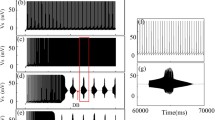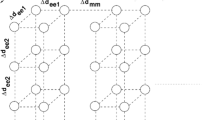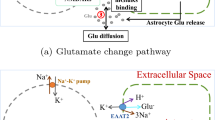Abstract
It has been revealed experimentally that astrocytes can participate in synaptic transmission by modulating and responding to the release of neurotransmitters with calcium elevations. Researches suggest that seizure-like discharges (SDs) or seizure-like firings (SFs) in neurons, characterizing neurological disorder, may arise locally in restricted areas (focal area) and then propagate throughout the brain. But the underlying mechanism remains unclear. To study the possible role astrocytes playing in the SDs propagation, we construct a minimal neuron-astrocyte network model by connecting a neurons chain and an astrocytes chain. The focal area is modelled by an IP3 reservoir which provides persistent IP3 out-flux. The study suggests that calcium wave propagation in astrocytes determines the propagation of SDs in the connected neurons. On the other hand, SDs in neurons allows the calcium wave propagates longer distance in the astrocytes, which suggests the mutually cooperating of astrocytes and neurons in accomplishing SD propagation. Furthermore, once SDs propagate and occupy the neuron network, it could not be terminated by recovery of the focal area. The results may imply that treatment of brain disorders should not only focus on local area but the whole neuron network.
Similar content being viewed by others
References
Deitmer J W, Rose C R, Munch T, et al. Leech glial cell: Functional role in a simple nervous system. Glia, 1999, 28: 175–182
Fan D, Wang Q, Perc M. Disinhibition-induced transitions between absence and tonic-clonic epileptic seizures. Sci Rep, 2015, 5: 12618
Hu B, Wang Q Y. The conditions for onset of beta oscillations in an extended subthalamic nucleus-globus pallidus network. Sci China Tech Sci, 2014, 57: 2020–2027
Wang Q, Perc M, Duan Z, et al. Synchronization transitions on scalefree neuronal networks due to finite information transmission delays. Phys Rev E, 2009, 80: 026206
Tang J, Ma J, Yi M, et al. Delay and diversity-induced synchronization transitions in a small-world neuronal network. Phys Rev E, 2011, 83: 046207
Wang Q Y, Duan Z S, Huang L, et al. Pattern formation and firing synchronization in networks of map neurons. New J Phys, 2007, 9: 383–383
Zhang H, Wang Q, He X, et al. Synchronization stability and firing transitions in two types of class I neuronal networks with short-term plasticity. Neural Netw, 2014, 49: 107–117
Auld D S, Robitaille R. Glial cells and neurotransmission. Neuron, 2003, 40: 389–400
Volterra A, Meldolesi J. Astrocytes, from brain glue to communication elements: The revolution continues. Nat Rev Neurosci, 2005, 6: 626–640
Giaume C, Koulakoff A, Roux L, et al. Astroglial networks: A step further in neuroglial and gliovascular interactions. Nat Rev Neurosci, 2010, 11: 87–99
Perea G, Navarrete M, Araque A. Tripartite synapses: Astrocytes process and control synaptic information. Trends Neurosci, 2009, 32: 421–431
Postnov D E, Ryazanova L S, Brazhe N A, et al. Giant glial cell: New insight through mechanism-based modeling. J Biol Phys, 2008, 34: 441–457
De Pittà M, Volman V, Berry H, et al. Computational quest for understanding the role of astrocyte signaling in synaptic transmission and plasticity. Front Comput Neurosci, 2012, 6: 98
Tang J, Luo J M, Ma J. Information transmission in a neuron-astrocyte coupled model. PLoS ONE, 2013, 8: e80324
Tang J, Liu T B, Ma J, et al. Effect of calcium channel noise in astrocytes on neuronal transmission. Commun Nonlinear Sci Numer Simul, 2016, 32: 262–272
Nadkarni S, Jung P. Spontaneous oscillations of dressed neurons: A new mechanism for epilepsy? Phys Rev Lett, 2003, 91: 268101
Hodgkin A L, Huxley A F. A quantitative description of membrane current and its application to conduction and excitation in nerve. J Physiol, 1952, 117: 500–544
Li Y X, Rinzel J. Equations for InsP3 receptor-mediated [Ca2+]i oscillations derived from a detailed kinetic model: A Hodgkin-Huxley like formalism. J Theor Biol, 1994, 166: 461–473
Parpura V, Haydon P G. Physiological astrocytic calcium levels stimulate glutamate release to modulate adjacent neurons. Proc Natl Acad Sci USA, 2000, 97: 8629–8634
Amiri M, Bahrami F, Janahmadi M. Functional modeling of astrocytes in epilepsy: A feedback system perspective. Neural Comput Applic, 2011, 20: 1131–1139
Amiri M, Montaseri G, Bahrami F. On the role of astrocytes in synchronization of two coupled neurons: A mathematical perspective. Biol Cybern, 2011, 105: 153–166
Amiri M, Hosseinmardi N, Bahrami F, et al. Astrocyte-neuron interaction as a mechanism responsible for generation of neural synchrony: A study based on modeling and experiments. J Comput Neurosci, 2013, 34: 489–504
Reato D, Cammarota M, Parra L C, et al. Computational model of neuron-astrocyte interactions during focal seizure generation. Front Comput Neurosci, 2012, 6: 81
Izhikevich E M. Simple model of spiking neurons. IEEE Trans Neural Netw, 2003, 14: 1569–1572
Allegrini P, Fronzoni L, Pirino D. The influence of the astrocyte field on neuronal dynamics and synchronization. J Biol Phys, 2009, 35: 413–423
Liu Y, Li C G. Firing rate propagation through neuronal-astrocytic network. IEEE Trans Neural Netw Learn Syst, 2013, 24: 789–799
Fellin T, Pascual O, Gobbo S, et al. Neuronal synchrony mediated by astrocytic glutamate through activation of extrasynaptic NMDA receptors. Neuron, 2004, 43: 729–743
Fellin T. Astrocytic glutamate is not necessary for the generation of epileptiform neuronal activity in hippocampal slices. J Neurosci, 2006, 26: 9312–9322
Goldberg M, De Pittà M, Volman V, et al. Nonlinear gap junctions enable long-distance propagation of pulsating calcium waves in astrocyte networks. PLoS Comput Biol, 2010, 6: e1000909
De Pittà M, Volman V, Levine H, et al. Coexistence of amplitude and frequency modulations in intracellular calcium dynamics. Phys Rev E, 2008, 77: 030903
Kazantsev V B. Spontaneous calcium signals induced by gap junctions in a network model of astrocytes. Phys Rev E, 2009, 79: 010901
Finkbeiner S M. Glial calcium. Glia, 1993, 9: 83–104
Charles A C, Merrill J E, Dirksen E R, et al. Intercellular signaling in glial cells: Calcium waves and oscillations in response to mechanical stimulation and glutamate. Neuron, 1991, 6: 983–992
Carmignoto G. Reciprocal communication systems between astrocytes and neurones. Prog Neurobiol, 2000, 62: 561–581
Oberheim N A, Wang X, Goldman S, et al. Astrocytic complexity distinguishes the human brain. Trends Neurosci, 2006, 29: 547–553
Sherwood C C, Stimpson C D, Raghanti M A, et al. Evolution of increased glia-neuron ratios in the human frontal cortex. Proc Natl Acad Sci USA, 2006, 103: 13606–13611
Di Garbo A, Barbi M, Chillemi S, et al. Calcium signalling in astrocytes and modulation of neural activity. Biosystems, 2007, 89: 74–83
Losi G, Cammarota M, Chiavegato A, et al. A new experimental model of focal seizures in the entorhinal cortex. Epilepsia, 2010, 51: 1493–1502
Postnov D E, Ryazanova L S, Sosnovtseva O V. Functional modeling of neural-glial interaction. Biosystems, 2007, 89: 84–91
Cressman Jr. J R, Ullah G, Ziburkus J, et al. The influence of sodium and potassium dynamics on excitability, seizures, and the stability of persistent states: I. Single neuron dynamics. J Comput Neurosci, 2009, 26: 159–170
Postnov D E, Koreshkov R N, Brazhe N A, et al. Dynamical patterns of calcium signaling in a functional model of neuron-astrocyte networks. J Biol Phys, 2009, 35: 425–445
Author information
Authors and Affiliations
Corresponding author
Rights and permissions
About this article
Cite this article
Tang, J., Zhang, J., Ma, J. et al. Astrocyte calcium wave induces seizure-like behavior in neuron network. Sci. China Technol. Sci. 60, 1011–1018 (2017). https://doi.org/10.1007/s11431-016-0293-9
Received:
Accepted:
Published:
Issue Date:
DOI: https://doi.org/10.1007/s11431-016-0293-9




